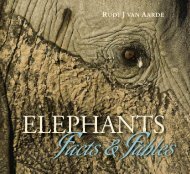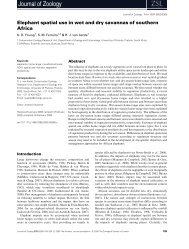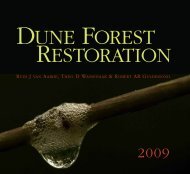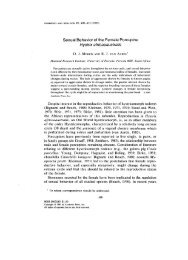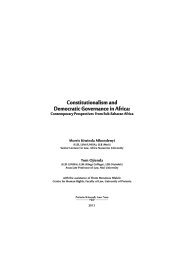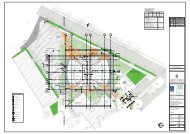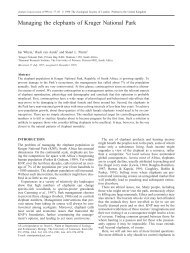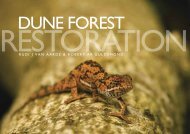Inheritance of the king coat colour pattern in cheetahs ... - CERU
Inheritance of the king coat colour pattern in cheetahs ... - CERU
Inheritance of the king coat colour pattern in cheetahs ... - CERU
Create successful ePaper yourself
Turn your PDF publications into a flip-book with our unique Google optimized e-Paper software.
578 R. J. VAN AARDE AND AN N VAN DYK<br />
Death <strong>of</strong> one <strong>of</strong> <strong>the</strong> parents and all <strong>the</strong> grandparents <strong>of</strong> <strong>the</strong> K<strong>in</strong>g <strong>cheetahs</strong>, <strong>the</strong> present <strong>in</strong>fertile<br />
status <strong>of</strong> <strong>the</strong> surviv<strong>in</strong>g male K<strong>in</strong>g cheetah, immaturity and a high rate <strong>of</strong> <strong>in</strong>fant mortality, are<br />
still preclud<strong>in</strong>g a programme <strong>of</strong> test-cross<strong>in</strong>g to prove fully that <strong>the</strong> <strong>k<strong>in</strong>g</strong> character is <strong>in</strong>herited<br />
as a recessive mutant. The future breed<strong>in</strong>g programme will be adapted and orientated towards<br />
this end.<br />
K<strong>in</strong>g <strong>cheetahs</strong> have been collected and observed <strong>in</strong> a restricted area <strong>in</strong> eastern and sou<strong>the</strong>astern<br />
Zimbabwe, <strong>the</strong> north-eastern Transvaal and eastern Botswana (Hill & Smi<strong>the</strong>rs, 1980).<br />
It is thus surpris<strong>in</strong>g that <strong>the</strong> grandfa<strong>the</strong>r (Chris) <strong>of</strong> <strong>the</strong> K<strong>in</strong>g <strong>cheetahs</strong> orig<strong>in</strong>ated from SW AI<br />
Namibia. We, however, have no reason to th<strong>in</strong>k that <strong>the</strong> SWA/Namibia cheetah population is<br />
isolated from o<strong>the</strong>r populations, imply<strong>in</strong>g that <strong>the</strong> observed mutation is not restricted to a<br />
specific area.<br />
Summary<br />
The fortuitous breed<strong>in</strong>g <strong>of</strong> K<strong>in</strong>g <strong>cheetahs</strong> at <strong>the</strong> De Wildt Cheetah Research Centre gives<br />
conclusive evidence that Ac<strong>in</strong>onyx rex simply represents an unusual <strong>colour</strong> variant <strong>of</strong> Ac<strong>in</strong>onyx<br />
jubatus. Consistency <strong>in</strong> <strong>the</strong> <strong>coat</strong> <strong>colour</strong> <strong>pattern</strong> <strong>of</strong> n<strong>in</strong>e K<strong>in</strong>g <strong>cheetahs</strong> born at <strong>the</strong> Centre, and<br />
<strong>the</strong> <strong>pattern</strong> <strong>of</strong> <strong>in</strong>heritance <strong>the</strong>re<strong>of</strong>, suggests that it is controlled by a recessive allele at a s<strong>in</strong>gle<br />
autosomal locus. The typical change <strong>of</strong> <strong>the</strong> spotted <strong>pattern</strong> to blotches is probably homologous<br />
to a mutation at <strong>the</strong> tabby locus <strong>of</strong> <strong>the</strong> Domestic cat.<br />
Dr T. J. Rob<strong>in</strong>son commented on <strong>the</strong> breed<strong>in</strong>g programme and we would like to thank him and Pr<strong>of</strong>.<br />
J. D. Sk<strong>in</strong>ner for critically read<strong>in</strong>g <strong>the</strong> manuscript. Dr D. G. A. Meltzer assisted <strong>in</strong> all aspects <strong>of</strong> <strong>the</strong><br />
breed<strong>in</strong>g programme and Mrs E. Humpel typed <strong>the</strong> manuscript.<br />
REFERENCES<br />
Brand, D. J. (1980). Captive propagation at <strong>the</strong> National Zoological Gardens <strong>of</strong> South Africa, Pretoria. Int. Zoo. Yb.<br />
20: 107 112.<br />
~'ooper, A. L. (1926). A curious sk<strong>in</strong>. Field 147: 690.<br />
Hills, D. M. & Smi<strong>the</strong>rs, R. H. N. (1980). The '<strong>k<strong>in</strong>g</strong> cheetah': a historical review. Arnoldia Rhodesia 9: 1-23.<br />
Pocock, R. 1. (1927). Description <strong>of</strong> a new species <strong>of</strong> Cheetah (Acillonyx). Proc. zool. Soc. Lond. 1927: 245252.<br />
Pocock, R. 1. (1939). The fauna <strong>of</strong> British India. Mammalia 1. Primates and Carnivora (<strong>in</strong> part). London: Taylor &<br />
Francis.<br />
Rob<strong>in</strong>son, R. (1970). Homologous mutants <strong>in</strong> mammalian <strong>coat</strong> <strong>colour</strong> variation. Symp. zool. Soc. Lond. No. 26:<br />
251-269.<br />
Rob<strong>in</strong>son, R. (1976). Homologous genetic variation <strong>in</strong> <strong>the</strong> Felidae. Genetica 46: 1···31.




